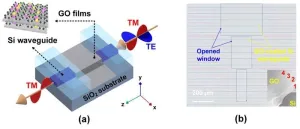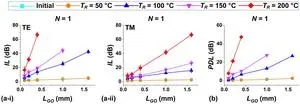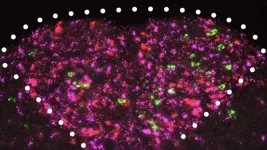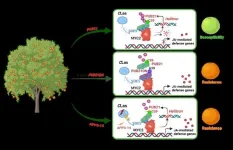A new publication from Opto-Electronic Sciences; DOI 10.29026/oes.2025.240032 , discusses integrated photonic polarizers with 2D reduced graphene oxide.
In modern optical systems, controlling light polarization is of fundamental importance and underpins a variety of advanced optical technologies. Optical polarizers, which selectively transmit light with a specific polarization orientation while blocking light of the orthogonal polarization, are essential components underpinning modern optical systems for a diverse range of applications. The applications are divided into four main categories, including optical sensing, imaging and display, optical analysis, and optical communications. For optical sensing applications such as navigation, astronomical detection, and atmosphere detection, optical polarizers enhance the sensitivity and accuracy by selecting the desired polarization state of incident light. The use of optical polarizers for imaging and display includes applications such as glasses, liquid crystal display, and photography, where optical polarizers help reduce glare, enhance contrast, and improve the color reproduction in displays, contributing significantly to image quality and visibility.
A variety of optical polarizers have been implemented based on different bulk material device platforms, such as refractive prisms, birefringent crystals, fiber components, and integrated photonic devices. Amongst these, integrated photonic polarizers, particularly those based on the well-developed silicon photonic platform, offer attractive advantages of compact footprint, low power consumption, and the capability for large-scale manufacturing. Nevertheless, the rapid advancement of photonics industries drives the demand for high-performance optical polarizers across broad wavelength ranges, which is usually challenging for optical polarizers based on bulk materials. Recently, owing to their high anisotropy in light absorption and broadband response, 2D materials have been on-chip integrated to realize high-performance optical polarizers. As an oxidized derivative of graphene, graphene oxide (GO) with facile fabrication processes for on-chip integration shows a high compatibility with integrated device platforms.
The research group of Professor David J. Moss from Swinburne University of Technology successfully integrate 2D GO films onto more widely used silicon (Si) photonic platform to realize waveguide and microring resonator (MRR) polarizers. This approach achieves precise control over the thickness, length, and position of the GO films by using a transfer-free, layer-by-layer coating method combined with accurate window opening in the chip cladding.
Figure 1(a) shows the schematic of an integrated waveguide polarizer based on a silicon photonic waveguide coated with a 2D GO film. The cross section of the silicon waveguide is 400 nm × 220 nm. The GO film has a thickness of 4 nm, which corresponds to 2 layers of GO fabricated using a solution-based self-assembly method. The article presents fabricated devices with 5 different lengths (ranging between ~0.1 mm and ~2.2 mm) for the opened windows, which correspond to different GO film coating lengths in the hybrid waveguides. As shown in Fig. 1(b), the good morphology of the coated GO films provides evidence for the high film uniformity achieved by the coating method.
As shown in Fig. 2(a-i), detailed measurements are performed for the fabricated devices with different structural parameters. Fig. 2(a-i) and 2(a-ii) show the measured insertion losses (IL) versus GO coating length (LGO) for transverse electric (TE) and transverse magnetic (TM) polarizations, respectively. Before the IL measurement, the silicon-on-insulator (SOI) chip was heated on a hot plate for 15 minutes at various temperatures TR. The IL increases with LGO for both polarizations. In Fig. 2(b), we further calculated the PDL (dB) by subtracting the TM-polarized IL (dB) from the TE-polarized IL (dB). As can be seen, the PDL increases with LGO, and it also increases with TR when TR ≥ 100 °C. The results show that the devices with reduced GO exhibit better performance than those with GO, achieving up to ~47-dB polarization-dependent loss (PDL) for the waveguide polarizer and ~16-dB polarization extinction ratio (PER) for the MRR polarizer.
Fig. 3(a) shows a microscopic image of the fabricated device with a monolayer GO film. The MRRs were fabricated together with the waveguides in Fig. 1(b) via the same processes. The radius of the MRRs was ~20 μm, and the length of the opened windows (i.e., the GO film coating length) was ~10 μm. The ring and the bus waveguide in the MRR had the same cross-section of ~400 nm × 220 nm ‒ identical to that for the waveguide polarizers in Fig. 2. Fig. 3(b) shows the measured extinction ratios (ER’s) of these MRRs. Fig. 3(c) shows the PER calculated from Fig. 3(b), which is defined as the absolute difference between the ER’s of the TE- and TM-polarized resonances. As shown, the hybrid MRR with unreduced GO exhibited a low polarization selectivity, with a PER of less than ~1 dB. In contrast, The PER increased with TR when TR ≥ 100 °C. After heating at TR = ~200 °C, the hybrid MRR exhibited a high PER of ~16 dB, highlighting its excellent polarization selectivity.
Keywords: integrated optics / 2D materials / graphene oxide / optical polarizers
# # # # # #
David J. Moss is Professor, Director of the Optical Sciences Centre at Swinburne University of Technology in Melbourne, and Deputy Director of the ARC Centre of Excellence COMBS (Centre for Optical Microcombs for Breakthrough Science). He was at RMIT University, 2014–16, the University of Sydney 1994–98; 2004–14 and JDS Uniphase 1998–03. He received his Ph.D. at the University of Toronto. He won the 2011 Australian Museum Eureka Google Science Prize. He is Fellow of the IEEE, Optica, and SPIE. His interests include optical microcombs, nanophotonics, nonlinear optics, quantum optics, microwave photonics, optical neural networks, 2D materials, and signal processing.
Baohua Jia received her B.Sc. and M.Sc. degrees from the Nankai University, China. She was awarded a Ph.D. from the Swinburne University of Technology, Australia in 2007. She is currently a full professor and an Australian Research Council Future Fellow at School of Science in RMIT University. Before joining RMIT, she was the founding director of Centre for Translational Atomaterials at Swinburne University of Technology. Her research focuses on laser nanoprinting and the fundamental light and nano- and atomaterial interaction. Prof. Jia is a Fellow of Optica.
Jiayang Wu received his bachelor’s degree from Xidian University, China in June 2010 and his Ph.D. degree from Shanghai Jiao Tong University, China in December 2015. After that, he joined Prof. David Moss’s research group in Swinburne University of Technology. He is currently a senior research fellow in the Optical Sciences Centre. His current research fields include integrated photonics, nonlinear optics, 2D materials, and optical communications. In 2021, Dr. Wu won the Australian National Research Award as the top researcher in the field of Optics & Photonics (only 1 person). He is a senior member of IEEE and Optica.
# # # # # #
Opto-Electronic Science (OES) is a peer-reviewed, open access, interdisciplinary and international journal published by The Institute of Optics and Electronics, Chinese Academy of Sciences as a sister journal of Opto-Electronic Advances (OEA, IF=15.3). OES is dedicated to providing a professional platform to promote academic exchange and accelerate innovation. OES publishes articles, reviews, and letters of the fundamental breakthroughs in basic science of optics and optoelectronics.
# # # # # #
More information: https://www.oejournal.org/oes
Editorial Board: https://www.oejournal.org/oes/editorialboard/list
OES is available on OE journals (https://www.oejournal.org/oes/archive)
Submission of OES may be made using ScholarOne (https://mc03.manuscriptcentral.com/oes)
CN 51-1800/O4
ISSN 2097-0382
Contact Us: oes@ioe.ac.cn
Twitter: @OptoElectronAdv (https://twitter.com/OptoElectronAdv?lang=en)
WeChat: OE_Journal
# # # # # #
Hu JK, Wu JY, Jin D et al. Integrated photonic polarizers with 2D reduced graphene oxide. Opto-Electron Sci x, 240032 (2025). doi: 10.29026/oes.2025.240032
END







